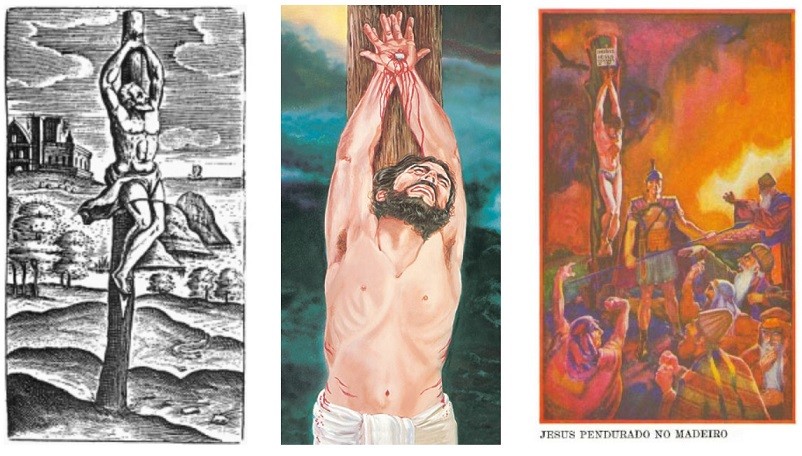
Christ’s Executional Device
Some Christians believe the device upon which Jesus Christ was executed was not in the shape of a cross – upright post with a crossbar– but was simply an upright post. The major proponents of this view are Jehovah’s Witnesses (the Watchtower Bible and Tract Society). Concerning Christ’s executional device their reference book Insight On The Scriptures states:
An instrument such as that on which Jesus Christ met death by impalement. (Mt 27:32-40; Mr 15:21-30; Lu 23:26; Joh 19:17-19, 25) In classical Greek the word (stauros’) rendered “torture stake” in the New World Translation primarily denotes an upright stake, or pole, and there is no evidence that the writers of the Christian Greek Scriptures used it to designate a stake with a crossbeam. [End of excerpt; emphasis added. The article then quotes from the book Non-Christian Cross by John Denham Parsons to support its statement.]
They further claim that the traditional cross is actually a pagan sex symbol. Their publication Reasoning From The Scriptures includes the following quote:
“Various figures of crosses are found everywhere on Egyptian monuments and tombs, and are considered by many authorities as symbolical either of the phallus [a representation of the male sex organ] or of coition. . . . In Egyptian tombs the crux ansata [cross with a circle or handle on top] is found side by side with the phallus.” — A Short History of Sex-Worship (London, 1940), H. Cutner, pp. 16, 17
Now consider what their Insight On The Scriptures says under the heading Sacred Pole:
The Sacred Poles. The sacred poles apparently stood upright and were made of wood, or at least contained wood, the Israelites being commanded to cut them down and to burn them. (Ex 34:13; De 12:3) They may have simply been uncarved poles, perhaps even trees in some instances, for God’s people were instructed: “You must not plant for yourself any sort of tree as a sacred pole.” – De16:21
Both Israel and Judah disregarded God’s express command not to set up sacred pillars and sacred poles; they placed them upon “every high hill and under every luxuriant tree” alongside the altars used for sacrifice. It has been suggested that the poles represented the female principle, whereas the pillars represented the male principle. These appendages of idolatry, likely phallic symbols, were associated with grossly immoral sex orgies, as is indicated by the reference to male prostitutes being in the land as early as Rehoboam’s reign. (1Ki 14:22-24; 2Ki 17:10) Only seldom did kings such as Hezekiah (and Josiah) come along, who “removed the high places and broke the sacred pillars to pieces and cut down the sacred pole.” – 2Ki 18:4; 2Ch 34:7.
Notice the above comments:
1. “The sacred poles apparently stood upright and were made of wood”;
2. “They may have simply been uncarved poles”;
3. “It has been suggested that the poles represented the female principle”; and
4. “These appendages of idolatry, likely phallic symbols, were associated with grossly immoral sex orgies.”
With its use of a simple wooden pole as Christ’s executional device, does it not appear that the Watchtower also is guilty of depicting Jesus’ execution upon a pagan sex symbol?
The Christian Greek Scriptures were written in common Greek, not classical. Therefore, even if stauros primarily denotes an upright stake or pole in classical Greek, that may not impact the meaning of its use in the Christian Greek Scriptures, whose writers adapted Greek terms to express non-Greek concepts. For example, Jehovah’s Witnesses would readily agree that when the Bible writers used hades to express the Hebrew concept of sheol, they did not intend the reader to incorporate the pagan concept of torment that was normally associated with hades. Execution upon a stauros was not a Greek method of punishment; it was Roman. Their language has the term crux which is translated into English as cross, and can refer to a simple upright stake or to one which has a patibulum, which is Latin for the cross-beam. Therefore, they must have used such an accessory on occasions.
The Scriptures do not describe the shape of the stauros used by the Romans in the execution of Jesus, but indirect evidence is provided. John 20:24, 25 tells us,
But Thomas, one of the twelve, who was called The Twin, was not with them when Jesus came. Consequently the other disciples would say to him: “We have seen the Lord!” But he said to them: “Unless I see in his hands the print of the nails and stick my finger into the print of the nails and stick my hand into his side, I will certainly not believe.”
Notice that the text speaks of “nails” in the plural. Looking at a Watchtower depiction of Jesus’ impalement, we see that only one nail is used in his hands, whereas the traditional depiction upon a cross has two nails, one in each hand. Of course, this is not totally conclusive in that they may have impaled Jesus upon a pole, using two or more nails to fasten his hands to it. No one can say for sure.
But this is not the only piece of evidence from the Bible. Consider Matthew 27:37,
Also, they posted above his head the charge against him, in writing: “This is Jesus the King of the Jews.”
Looking at a Watchtower depiction of Jesus’ impalement, we find that the sign proclaiming the charge against him is above his hands, not his head. Of course, it might be argued that if it is above his hands, it is also above his head. But if one reads the Bible without any pre-conceived ideas, in which place would one envision the location of the charge, immediately above his head, or above his hands?
The significance of Jesus’ death is irrelevant to the shape of the executional device. The truth of the matter is neither the Watchtower nor Christianity is guilty of using sex symbols in their depictions of Jesus’ death since neither regards their respective devices in such a manner. But we would suggest that the Jehovah’s Witnesses pay careful attention to Jesus’ words recorded at Matthew 7:3-5,
Why, then, do you look at the straw in your brother’s eye, but do not consider the rafter in your own eye? Or how can you say to your brother, ‘Allow me to extract the straw from your eye’; when, look! a rafter is in your own eye? Hypocrite! First extract the rafter from your own eye, and then you will see clearly how to extract the straw from your brother’s eye.
We can little doubt that all geometric shapes, including the cross, have been used at times and in places by pagans. But of what does the average person today think when seeing a cross? Most people think of Christianity, at the very least, and hopefully, of Jesus Christ and the sacrifice he made. Only a certain few think of sex when seeing a cross!
The cross has been rescued by history from its pagan and vulgar association. How sad it is that a few Christians, failing to appreciate this, seek to end the silent testimony to God’s love that the cross bears today, and restore it to the powers of darkness from which it has been freed for many centuries.

